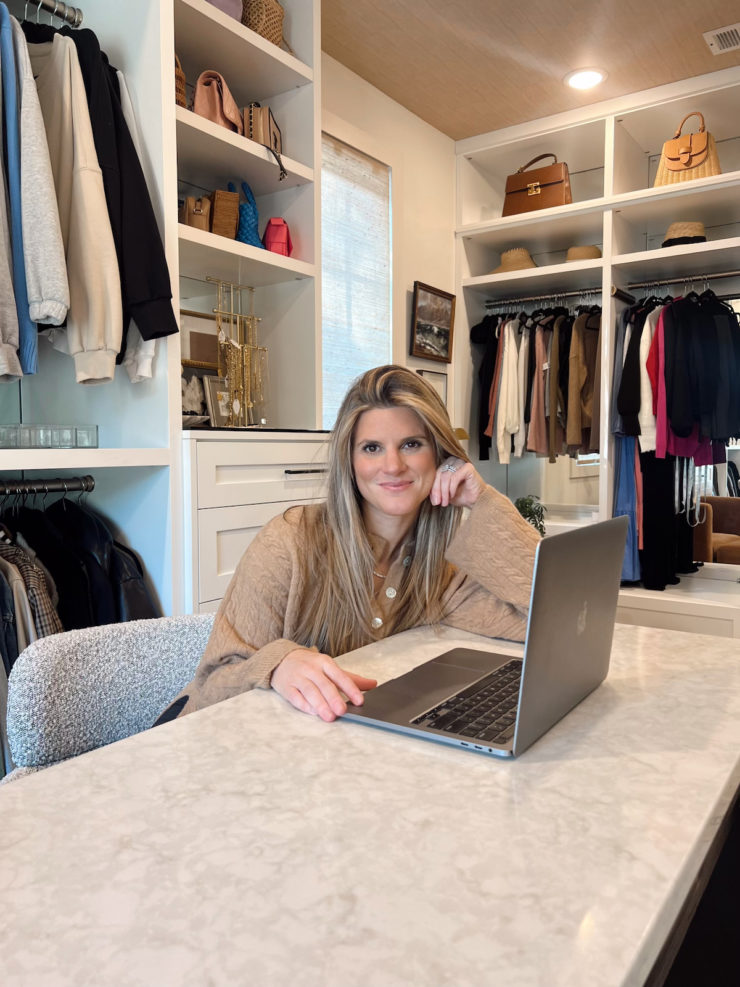Motivation - January 31, 2023
How I Stay Organized in My Business
A few weeks ago I shared a screenshot from my project management software, Asana, and several of you asked me to talk more about how I stay organized in my professional and personal life.
For me, the two are pretty intertwined, and I’ve found it easiest to use the same project manager for both. I’ve been using Asana for over 6 years and absolutely LOVE it.
It’s mostly for my business, but since I’m in it almost daily, I also use it to keep my personal life organized as well. If you’re someone that gets overwhelmed easily (like me!), I truly think you’d appreciate using a tool like this project management software because it helps you break big things into smaller tasks.
When I’m feeling overwhelmed, I do a big brain dump, and then I ultimately insert everything I want to accomplish from the dump into Asana, then task it out with deadlines. If I don’t have deadlines, I won’t get anything done. I have to. And I have to see things in a calendar view.
I thought I’d address how I stay organized in my business first. Realistically, I probably need a separate post for my personal life because there’s just so much — so stay tuned for that!
How I Stay Organized in My Business
Gmail tags
I have a color-coded label I apply to all potential work projects so they stick out to me in my inbox. I know everyone has a different system for tackling emails, but for me personally, I operate on the “unread” principle. Basically, if the email is marked unread, it still needs attention or requires something from me. I also use the tags for ongoing work projects so I know to prioritize those emails.
Ongoing, repeating tasks
I have several repeating tasks in Asana that automatically repeat on a weekly, monthly, or annual basis. These tasks are things that must get done on a periodic basis and having the repeating task saves me the brain space and time of continually re-creating it. For example, I have repeating tasks for things like the following (to name a few):
- closet purge and run donations (monthly)
- run returns (every 15 days)
- upload images to my Pinterest folder (weekly)
- post Currently Loving (a series I do every Sunday night)
- assign LTK tasks for the month (monthly) – I have a different calendar for LTK that needs to be updated each month.
- transfer funds (every 2 weeks, I transfer funds from the incoming account to my operating account, taxes, etc.)
- the list goes on…
Templates in Asana
I used to use these a lot more when I posted more often to the blog. Currently, I’m only posting 2-3 times a week. But I have a template for “new blog post” that details every single task that must be completed to make that blog post happen. I use a template and just duplicate each time, modifying the tasks for that specific post. This helps because then I don’t have to think through all the steps every single day – it’s just already there and I can delete or modify as it pertains to this post. I have templates for IG reels as well and a few other common post types that we use on a regular basis.
Shared notes
We literally could not operate my business without shared notes. I literally use them on a DAILY basis for work. I use them for little things like editing captions we’re planning to post or approving copy for text overlays on stories. I also use shared notes for shopping lists (like for upcoming content) and even image inspiration for something we’re shooting soon.
Shared albums
Just like shared notes, we LIVE by using shared albums to exchange photos and videos. Sometimes when you’re transferring media via text message or even email, the quality gets tampered with. I’ve found that I’ve had the least amount of issues when using shared albums. We’ve been using them for 3+ years.
Google Calendar
I’m a visual person, so I absolutely love using Google Calendars so I can see all my time blocks laid out. Since having kids, I don’t really get full days anymore. Between drop-offs and other mom duties, I usually only realistically have 3-4 hours of good focus working time — if I even get that!
Each week, either on Friday or Sunday, I map out the week ahead by using my Google Calendar week view. This allows me to be realistic about getting it all in. I even use it for mapping out transportation time, prayer time, bath time, etc. It has been incredibly critical for me. I try to lump similar tasks together so I can get the most done. For instance, if I have 3 campaigns I need to film and 2 posts to write, I’ll film all 3 campaigns during a 3-hour block of time on one day and then have focused writing time on another day.
Brainstorming blocks
I was going to say brainstorming days but realistically, it’s never a full day. Each month, I try to have a designated amount of time dedicated to coming up with content ideas. Then I’ll take those ideas and put them into Asana as potential pieces of content. This helps keep me on task instead of trying to come up with ideas every single time I go to film. This way, when it’s time to film, I already have a basic idea of what I’m going to do, I just need to execute it.
Orders spreadsheet
This is pretty niche for my business, but it’s a major way I stay organized and something I’ve been doing since the VERY beginning. Every influencer is different, but I buy almost all of my own clothing. And because of the nature of what I do, I have to do a lot of shopping since I try to wear and style things that are available for my audience to shop.
I think something people don’t often realize is that this means there are A LOT of inflowing products all the time. At the beginning of my career, all the online orders would overwhelm me — trying to keep track of return dates, what worked, what didn’t, etc. So I created a pretty robust spreadsheet for me to keep track of all the orders I’m placing for work.
I mark down every single thing I buy for work so I can keep track of how much I’ve spent. I also use this to reconcile my credit card statement. It’s annoying and a bit more work, but this spreadsheet has saved my sanity. I can then compare how much I made with affiliate sales that month to how much I spent. It gives me peace of mind.
Captioning my photos on iPhone
I’ve shared this before on stories, but I try to caption my photos on my phone. I do this so that I can easily find that same photo when a reader asks a question weeks or months later. For instance, I’ll caption a photo of me wearing LAKE Pajamas with “LAKE Pajamas” so that I can easily find that photo in the future without having to scroll through hundreds of other photos. I have xxx photos on my phone, so this definitely comes in handy. I don’t always do it, but when I do, it’s SO helpful.
Slack
I go through seasons of using this tool more than others. Right now, I’m mostly using text messages to communicate with my team, but in the past when we’ve been creating a ton of content, Slack has come in handy. For instance, I used a Slack channel to store all my screenshots with reader questions. Then when I had time to answer the questions, I’d sit down and answer them all in one place and have my assistant post them. This was much more efficient than going through all my screenshots on my phone (I screenshot questions since I usually cannot answer them at the moment when I see them).
Here’s a list of all the apps I use:
- Asana
- Slack
- iPhone photos
- Shared albums
- Gmail
- Google Calendar
- Dropbox
- Notes app
- Google Sheets
- Google Docs
- LTK
Brighton Your Day
Get exclusive content, sale items, and lots of fun stuff, straight to your inbox!



Share Story:
Join the Conversation
0 / View All